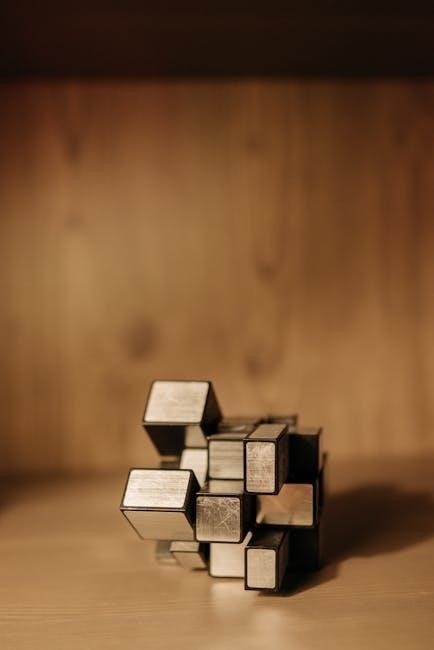Understanding 3D Puzzles
3D puzzles offer a unique construction experience, diverging from traditional flat jigsaws. They challenge spatial reasoning and fine motor skills, requiring builders to assemble pieces in three dimensions. These puzzles often replicate real-world objects.
Types of 3D Puzzles
3D puzzles come in diverse forms, each presenting unique assembly challenges. Crystal puzzles involve interlocking transparent pieces to form a sleek, translucent model, often without glue. Wooden puzzles frequently feature intricate, laser-cut components that interlock to create mechanical models or architectural structures. Jigsaw-based 3D puzzles use curved or shaped pieces to build spherical or organic shapes.
Additionally, there are foam-backed puzzles suitable for younger builders, replicating famous landmarks. Metal puzzles, like miniature vehicles or robots, demand precision and patience. Understanding these different types is crucial, as assembly techniques vary significantly.
Choosing a type aligned with your skill level ensures a fulfilling experience.
Benefits of Assembling 3D Puzzles
Assembling 3D puzzles offers a multitude of cognitive and developmental benefits. They enhance spatial reasoning, requiring you to visualize and manipulate objects in three dimensions. The process sharpens problem-solving skills as you analyze piece shapes and identify connections. Fine motor skills are improved through the precise handling of small components.
Puzzles promote concentration and focus, fostering a meditative state that reduces stress. Completing a challenging puzzle boosts self-esteem and provides a sense of accomplishment. Furthermore, many 3D puzzles replicate historical landmarks or mechanical devices, offering educational opportunities. Engaging with these puzzles can spark curiosity and inspire further learning.
They are an excellent way to unwind and disconnect from screens.

Preparing for Assembly
Before diving into your 3D puzzle, careful preparation is key. This involves selecting an appropriate puzzle, setting up a dedicated workspace, and thoroughly familiarizing yourself with all the puzzle pieces and instructions.
Choosing the Right Puzzle
Selecting the right 3D puzzle is crucial for an enjoyable experience. Consider your skill level; beginners might opt for simpler designs with fewer pieces and clear instructions. Evaluate the puzzle’s complexity, taking note of the piece count and overall design intricacy. For newcomers, crystal puzzles or smaller wooden models can be a great starting point.
Examine the puzzle’s theme and subject matter to ensure it aligns with your interests, be it architecture, vehicles, or animals. Look at the material of the puzzle and the quality of the pieces. High-quality materials and well-defined instructions will contribute to a smoother assembly. Read reviews and consider the age recommendation to gauge the suitability of the puzzle, ensuring it offers a satisfying and achievable challenge.
Workspace Setup
Preparing your workspace is essential for a smooth 3D puzzle assembly. Choose a clean, well-lit area with ample space to spread out the puzzle pieces without obstruction. Good lighting is crucial for identifying small details and connecting pieces accurately. Cover your work surface with a mat or cloth to prevent scratches and provide a non-slip surface.
Gather any necessary tools like small containers for sorting pieces, tweezers for handling delicate parts, and a soft cloth for wiping away dust. Keep the instructions readily accessible and ensure you have enough room to maneuver around the puzzle as it grows. Minimize distractions in your workspace to maintain focus and prevent errors. A well-organized and comfortable environment will significantly enhance your puzzle-solving experience and improve the final outcome.
Inventory and Familiarization
Before diving into assembly, take time for a thorough inventory and familiarize yourself with the puzzle components. Carefully unpack all pieces and compare them against the parts list in the instructions. Ensure that all necessary components are present and undamaged. Sorting the pieces by shape, size, or color can significantly streamline the assembly process.
Study the puzzle’s instructions and examine the diagrams to understand how the pieces fit together. Pay close attention to any unique features or markings on the pieces. Familiarize yourself with the puzzle’s overall structure and identify key sections or modules. This initial investment of time will save frustration later and help you approach the assembly with confidence. Understanding the puzzle’s design will allow you to anticipate challenges and develop effective strategies for connecting the pieces correctly.

Step-by-Step Assembly Guide
This section provides a structured approach to assembling your 3D puzzle. We will cover understanding instructions, piece identification, and correct connection techniques for a smooth and enjoyable building experience.
Reading the Instructions
The first crucial step in assembling any 3D puzzle is carefully reading the instructions. Most 3D puzzles come with detailed booklets or online guides that outline the assembly process step by step. These instructions often include diagrams, illustrations, or even videos to help you understand how the pieces fit together.
Pay close attention to any specific symbols, notations, or warnings included in the instructions, as these can provide valuable insights into the puzzle’s design and construction. Look for numbered steps or sequences that indicate the order in which the pieces should be connected. Some instructions might offer tips or tricks for assembling certain sections of the puzzle more easily.
Before you even touch a puzzle piece, take the time to thoroughly review the instructions and familiarize yourself with the overall assembly process. This initial investment of time will save you frustration and errors down the line, leading to a more satisfying puzzle-solving experience.
Identifying Puzzle Pieces
After carefully reading the instructions, the next essential step is to identify and sort the puzzle pieces. 3D puzzles often consist of numerous components, each with a unique shape, size, and marking. Taking the time to properly identify these pieces will streamline the assembly process and prevent frustration.
Refer to the instructions or the puzzle box for a parts list or diagram that illustrates each piece and its corresponding label or number. Lay out the pieces on your workspace and compare them to the illustrations. Group similar pieces together to make them easier to find later on.
Some 3D puzzles use color-coding to differentiate between pieces or sections of the puzzle. Pay attention to these color cues, as they can provide valuable clues about how the pieces fit together. If the pieces are labeled, consider using small containers or trays to keep them organized by number or letter. This will save you time searching for specific pieces during assembly.
Connecting Pieces Correctly
Once you have identified the puzzle pieces, the next crucial step is connecting them correctly. This requires careful attention to the instructions and a good understanding of how the pieces are designed to interlock. Most 3D puzzles rely on a system of tabs, slots, or pegs that fit together in a specific way.
Start by identifying the pieces that form the base or core of the puzzle. These pieces usually have larger connection points or markings that make them easy to recognize. Gently align the tabs and slots of the pieces you want to connect, and then apply gentle pressure until they snap or slide into place.
Avoid forcing the pieces together, as this can damage the puzzle or break the connection points. If a piece doesn’t seem to fit easily, double-check the instructions to ensure you are using the correct pieces and connecting them in the correct orientation. Some puzzles may require you to rotate or flip a piece before it will fit properly.

Troubleshooting Common Issues
Assembling 3D puzzles can present challenges. Addressing missing parts, connection difficulties, and understanding labels is key. Utilizing online resources and tutorials can provide solutions for smooth construction.
Missing Pieces
Discovering a missing piece in your 3D puzzle can be frustrating, but there are steps you can take to address the issue. First, carefully retrace your steps and thoroughly search the surrounding workspace. Small pieces can sometimes be easily overlooked or may have fallen onto the floor. Double-check the puzzle box and any packaging materials, as pieces can occasionally be stuck within.
If the piece remains elusive, contact the puzzle manufacturer. Many companies offer replacement parts for missing components, especially for newer puzzle sets. Provide them with the puzzle’s name, model number, and the specific piece identifier, if available. Some manufacturers may require proof of purchase.
While awaiting a replacement, consider whether the missing piece impacts structural integrity. If not, you might proceed with the assembly, leaving that area for last. In some cases, you might even be able to temporarily substitute a similar-sized piece from another puzzle or material, just to visualize the final form. Remember to document the missing piece for future reference.
Difficulty Connecting Pieces
Encountering resistance when connecting 3D puzzle pieces is a common issue, often stemming from incorrect alignment or slight imperfections in the manufacturing. First, ensure you’re using the correct pieces for the designated slot, referencing the instruction manual’s diagrams. Verify the piece’s orientation; many pieces are designed to fit only one way.
Apply gentle, even pressure when attempting to join pieces. Avoid forcing them, as this can damage the pieces or the puzzle’s overall structure. If resistance persists, examine the connecting tabs and slots for any obstructions or deformities. A small file or hobby knife can carefully remove minor imperfections.
Sometimes, the surrounding pieces can create tension, making it harder to insert a new piece. Try loosening nearby connections slightly to provide more wiggle room. If the puzzle utilizes interlocking mechanisms, ensure they are properly engaged. Patience is key; persistent but gentle effort will usually resolve connection difficulties.
Understanding Part Labels
Navigating the intricate world of 3D puzzles often requires deciphering part labels, which are crucial for accurate assembly. Puzzle manufacturers employ various labeling systems, typically using numbers, letters, or a combination of both to identify individual pieces. These labels usually correspond to a specific step or section within the instruction manual.
Before commencing assembly, carefully familiarize yourself with the puzzle’s labeling scheme. The instruction manual generally includes a parts list or diagram that visually depicts each piece and its corresponding label. Take time to cross-reference the physical pieces with the labels in the manual, ensuring you can readily identify each component.
Some puzzles utilize color-coding in addition to numerical or alphabetical labels. Pay close attention to these color cues, as they often indicate the correct placement or orientation of a piece. When encountering similar-looking pieces, always double-check the part labels to prevent errors. Misinterpreting the labels can lead to structural instability.

Resources for Assembly Instructions
Many resources exist if you need help. These include online databases, video tutorials, and PDF manuals. These comprehensive guides offer visual and written aid for successful puzzle completion.
Online Databases
For those struggling with their 3D puzzle assembly, online databases serve as invaluable repositories of information. These platforms often host a vast collection of assembly instructions, catering to a wide variety of puzzle types and brands. These resources frequently include user-submitted tips, tricks, and solutions to common challenges, creating a collaborative environment for puzzle enthusiasts.
Users can typically search for their specific puzzle model, accessing detailed diagrams, step-by-step guides, and even interactive 3D models that aid in visualizing the assembly process. Some databases also offer forums where users can connect, ask questions, and share their experiences, fostering a sense of community and mutual support.
These digital resources are particularly helpful when physical instruction manuals are lost or damaged, ensuring that builders always have access to the guidance they need.
Video Tutorials
Video tutorials provide a dynamic and visual approach to 3D puzzle assembly, offering a step-by-step demonstration of the entire process. These tutorials are particularly beneficial for visual learners who prefer to observe the assembly process rather than relying solely on written instructions. Many creators and puzzle enthusiasts upload videos showcasing their techniques, providing diverse perspectives on puzzle-solving strategies.
These tutorials often include close-up shots of intricate connections, highlighting the correct orientation and alignment of puzzle pieces. They can also offer troubleshooting tips for common challenges, such as dealing with missing pieces or difficult connections.
By watching experienced builders assemble the puzzle, viewers can gain a deeper understanding of the puzzle’s structure and mechanics. Furthermore, video tutorials can be paused, rewound, and replayed, allowing viewers to learn at their own pace and revisit complex steps as needed.
PDF Manuals
PDF manuals offer a comprehensive and portable resource for assembling 3D puzzles. They provide detailed, step-by-step instructions, often accompanied by clear diagrams and illustrations, guiding users through the entire construction process. Many manufacturers offer downloadable PDF versions of their assembly manuals on their websites, ensuring easy access for users who may have misplaced the physical copy or prefer a digital format.
PDF manuals often include a complete inventory of puzzle pieces, allowing users to verify that all components are present before beginning assembly. They also provide detailed explanations of intricate connections, highlighting the correct orientation and alignment of puzzle pieces.
The digital format allows users to zoom in on specific sections for a closer look at the details. Furthermore, PDF manuals can be easily printed, allowing users to have a physical copy of the instructions for convenient reference during assembly. These are often found on the manufacturer’s website.

